The Novodevichy Convent is deeply connected to Russia’s political, cultural and religious history. It is one of the most magnificent examples of Moscow Baroque architecture preserved in Russia to this day, home to a treasure trove of religious artifacts and artwork, and is the resting place of Russia’s most eminent figures. The Novodevichy Convent remains an integral part of ancient Moscow tucked into the city rapidly expanding around it, and has been recognised as a UNESCO World Heritage Site. Today, it is one of Moscow’s most popular tourist attractions.
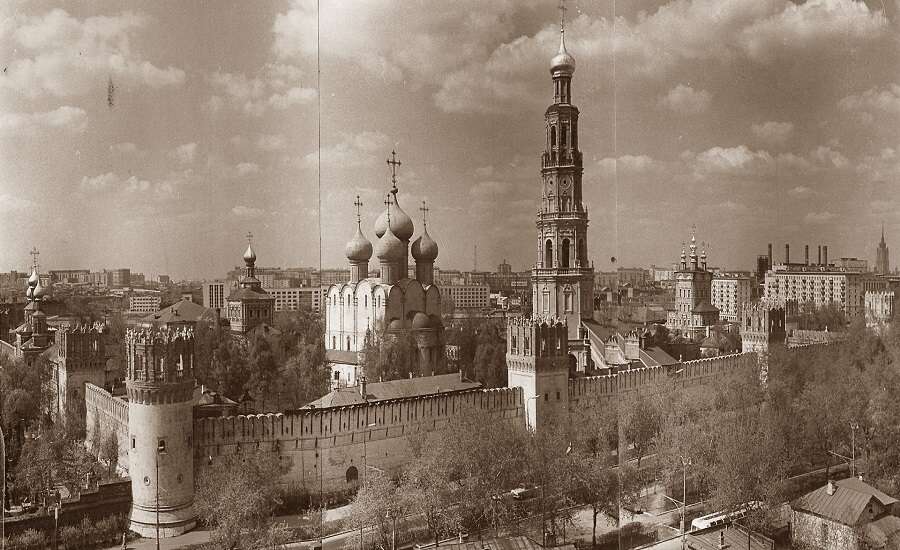
Photo from https://www.moskvahod.ru/
The Novodevichy Convent was founded in May 1524 by Grand Prince Vasily III to celebrate the annexation of Smolensk from Lithuania, a major victory for Russia. The convent was dedicated to the Smolenskaya icon of the Holy Mother of Hodigitria, which had been present in Smolensk during the pivotal battle and was subsequently brought to the convent. The icon of the Holy Mother of Hodigitria had also been the most sacred icon of Byzantium before being transferred to Russia. Vasily’s mother, Sofia Paleologue, was the niece of the last emperor of Byzantium, and Vasily considered Russia to be the successor to the Byzantine Empire – a perception reinforced by the presence of this icon in Russia’s capital. For the next 400 years, a procession commemorating the arrival of the icon took place each summer, leading from the Kremlin to the Novodevichy Convent and accompanied by large festivities.
Did you know? As well as holding a sacred place in Moscow’s religious life, the Novodevichy Convent also served as part of the city’s defence system, surrounded by fortification walls and towers and defended by a garrison.
From the mid-1500s to the late 1600s, the Novodevichy Convent was the site of royal baptisms, burials and coronations, the chosen convent for members of the imperial family and nobility, and a sanctuary during the Time of Troubles. It became extremely rich, endowed with land, peasants, and tax breaks. The convent reached the height of prosperity under Peter the Great’s half-sister Sofia, ruling as his regent in the late 1600s, who commissioned the unique architectural ensemble in the Moscow Baroque style that we see today.
Did you know? After Peter the Great assumed power in 1689, Sofia was confined to the Novodevichy Convent and imprisoned for life!
Although the Novodevichy Convent lost its influence in the 18th century, it did not cease its activities and by the 19th century housed a community of 300 nuns engaged in church activities, breadmaking, vegetable growing, painting, and needlework - in particular, intricate embroidery with gold thread (a traditional craft in Russian monasteries and convents). The convent also housed a school and shelter for orphaned girls, a hospital, and almshouses for elderly sisters. They continued their charitable and community efforts during the First World War, nursing soldiers, sewing uniforms, and collecting parcels for the war front.
Did you know? The French occupied Novodevichy Convent for a month in the autumn of 1812. Upon retreat, they mined the convent’s cathedrals with powder kegs and started a fire; luckily, the sisters who remained at the convent were able to extinguish the flames and spare the convent.

Photo from https://pastvu.com/
The activities of the Novodevichy Convent were disrupted by the advent of the Soviet regime. Its charitable and educational projects were shut down, its money confiscated, and its land and buildings transferred to the Red Army and workers. The convent was abolished in 1922 and around 700 people settled on the territory. A branch of the State History Museum was established there in 1934 – the Museum of the Era of Princess Sofia and the Streltsy Riots – where the former nuns worked as restorers, janitors and watchmen. Not all of the convent was treated with respect during the Soviet era. At the turn of the 20th century there were nearly 3,000 tombs in the Novodevichy Necropolis, the resting place of prominent Tsarist-era figures. After the destruction of Moscow’s necropolises during the 1930s, less than one hundred graves remained.
Did you know? Religious activity resumed in the Novodevichy Convent as early as 1944, and it continued to play an openly important role in Moscow’s religious life during the remaining Soviet years.
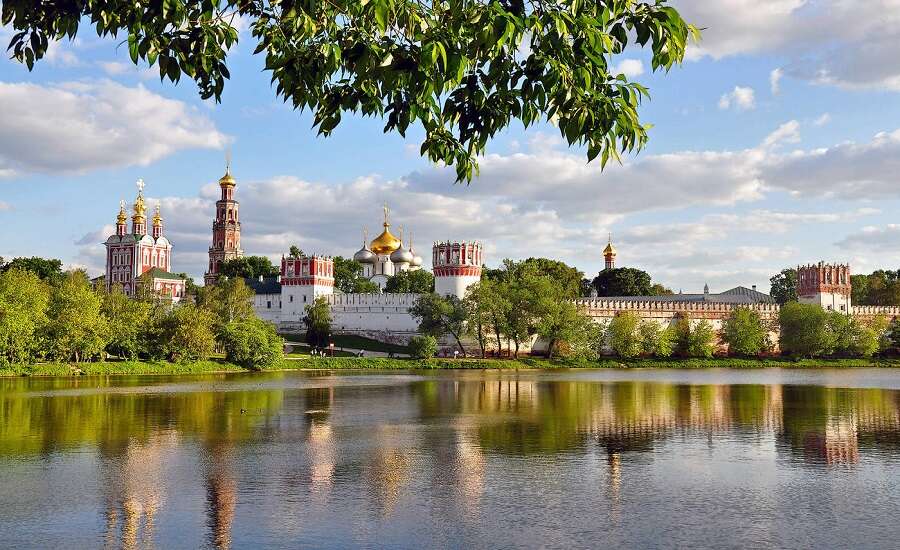
Photo from https://photocentra.ru/
The Novodevichy Convent has operated as a working convent since 1994, and in 2011 the Russian government gave it to the Moscow Diocese. The decision to transform the convent into a museum in the Soviet period, combined with exceptional restoration work carried out in the late 20th century, meant that the majority of the ensemble remains preserved to this day. The Novodevichy Convent was recognised by UNESCO as a World Heritage Site in 2004, and is today one of Moscow’s most popular attractions.
Did you know? The convent’s first Abbess in the post-Soviet period was Abbess Seraphima. Earlier in life she was a professor of technical sciences, awarded the Soviet State Prize for her work on developing space suit materials and latex technology. Despite living her whole life under the Soviet regime, she never renounced her faith and became the Abbess after retirement.
Churches: The Novodevichy Convent is home to nearly 10 churches and chapels, some in the white stone Byzantine styles of Kievan Rus, and others in the magnificent style of Moscow Baroque, decorated with murals and elaborate iconostases
As the chosen convent for royal and noble women seeking to take the veil, the design of the Novodevichy Convent reflects its elite nature. It is renowned for its harmonious Moscow Baroque architecture, one of the most complete embodiments of the style in Russia today. The convent is enclosed by nearly a kilometre of crenellated white stone walls up to 11 metres tall and 5 metres thick and punctuated by twelve fortified towers, and comprises residential buildings, former imperial quarters, a number of beautiful churches, and the Novodevichy Necropolis and Cemetery.

Photo from https://kartarf.ru/
Smolensky Cathedral is the main temple of the ensemble, and the convent’s oldest and largest stone building, topped with four silver domes and one central gold dome. Its interior is decorated with rare frescos from the 16th to 17th centuries and a magnificent five-tier gilded iconostasis with icons contributed by the Russian tsars. The cathedral houses the tombs of Peter the Great’s wife Evdokia, and his sisters Ekaterina, Evdokia, and Sofia.
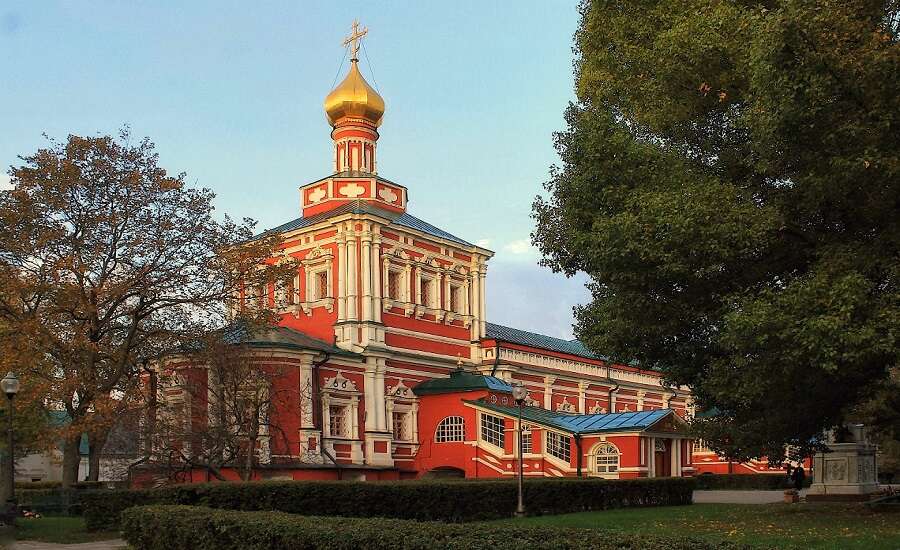
Photo from https://photocentra.ru/
This church is distinguished for its architectural beauty, with white window frames, cornices and columns contrasting the deep red bricks. The interior is a large atmospheric hall not dissimilar to a ballroom, with wide windows, an arched ceiling, chandeliers, gold framed icons lining each wall, and an 18th century iconostasis.

Photo from https://sobory.ru/
Sitting atop the convent’s southwestern gate, this church is topped with two-tiered side towers and a large central tower crowned with a golden dome, an arrangement characteristic of Ukrainian religious architecture. It was used as the domestic chapel of Tsarevna Maria, Peter the Great’s half-sister.

Photo from https://photocentra.ru/
An impressive church completed in 1689, which towers above the convent’s northern gate. Its architecture is incredibly harmonious – tall walls are lined with rows of white framed windows topped with shell-like white stone carvings, four small towers and one central tower, each crowned with a golden dome. The enormous multi-tier iconostasis was created by icon master Karp Zolotarev and has been preserved to the present day. The church is adjoined by the Lopukhinsky Chambers, residence of Peter the Great’s first wife Evdokia.
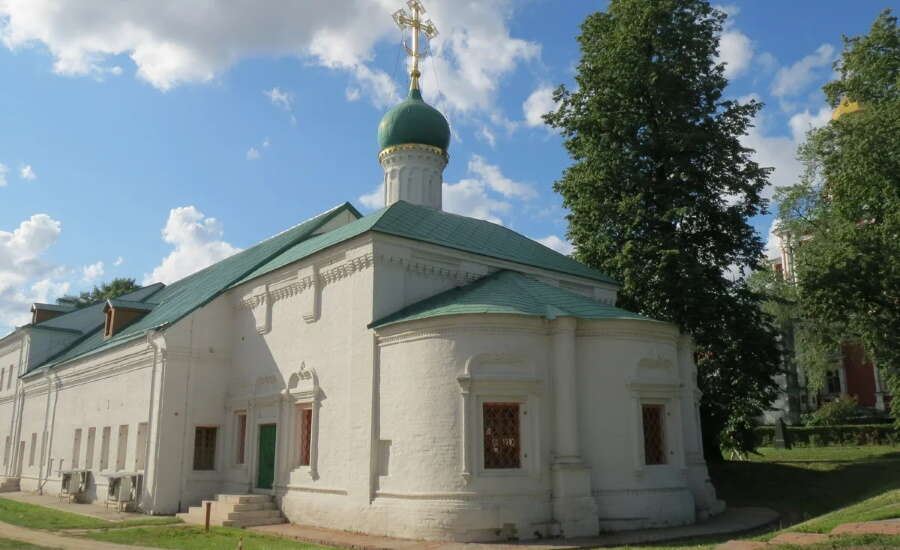
Photo from https://fotovmire.ru/
This small white church is the second-oldest architectural monument of the convent’s ensemble. It adjoins the chambers of Irina Godunova, sister of Tsar Boris Godunov.
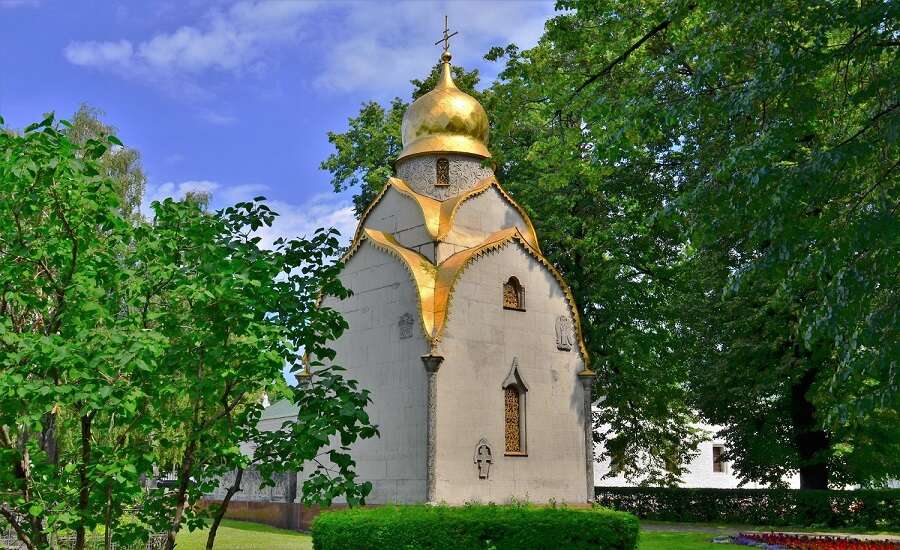
Photo from http://fotokto.ru/
A tiny chapel erected over the tomb of the famous Prokhorov manufacturing family. The chapel was designed in Neo-Russian architectural style, framed with elegant metalwork, layers of semi-circular kokoshniki, and topped with a large golden dome.
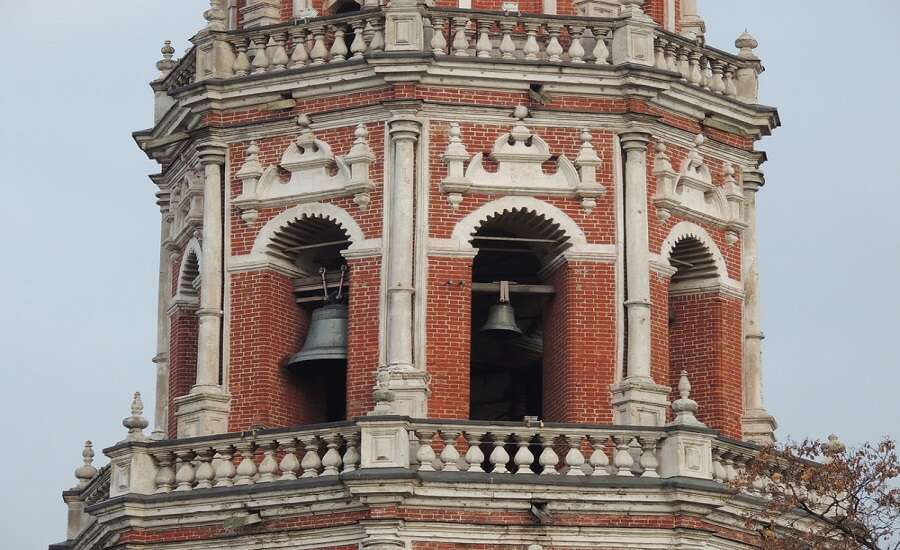
Photo from https://russian-church.ru/
Constructed in the last year of Princess Sofia’s regency, the bell tower is considered one of the most beautiful and imposing in Moscow and has no parallels in Russian religious architecture. The 72-metre tower comprises six octagonal tiers decorated with white balustrades. The third and fifth tiers contain bells, and the bottom two are occupied by churches. Due to its great height, the bell tower would have been visible for miles around.
Did you know? Eminent Soviet architect and artist Vladimir Tatlin set up his workshop in the defunct bell tower in the 1920s and 1930s. He developed his famed ‘Letatlin’ glider here, which unfortunately failed to take flight.

Photo from https://novodev.msk.ru/
Various exhibitions of history and art are organised in the Novodevichy Convent.
An exhibition dedicated to the first Abbess of the Novodevichy Convent in the post-Soviet period, Varvara Vasilievna Chernaya. Visitors can see archival photographs of Abbess Seraphima’s life, personal items and family memorabilia, and church and state awards. Located in the Naprudnaya Tower.
This exhibition explains how the convent survived Napoleon’s invasion of Moscow, and displays general information about the battles which took place during the war of 1812. It includes uniforms, artifacts from the Battle of Borodino, fragments from destroyed churches, and portraits of historical, military and religious figures. Located in the Naprudnaya Tower.
An exposition of the Novodevichy’s entire collection of icons of the Virgin Mary, with over 80 icons of different styles and periods, including some of Russia’s most revered icons. Located in the Naprudnaya Tower.
This exhibition shows how Moscow’s churches were rebuilt from ruins in the post-Soviet era, and showcases Moscow’s historical, cultural and religious heritage from the Stalinist period to the present day with a collection of photos and videos. Located in the Naprudnaya Tower.
Housed in different buildings of the convent complex, this exhibition includes icons from the early 1700s of Russian and Western schools of painting, wooden religious sculptures, and important architectural features of the convent’s ensemble.
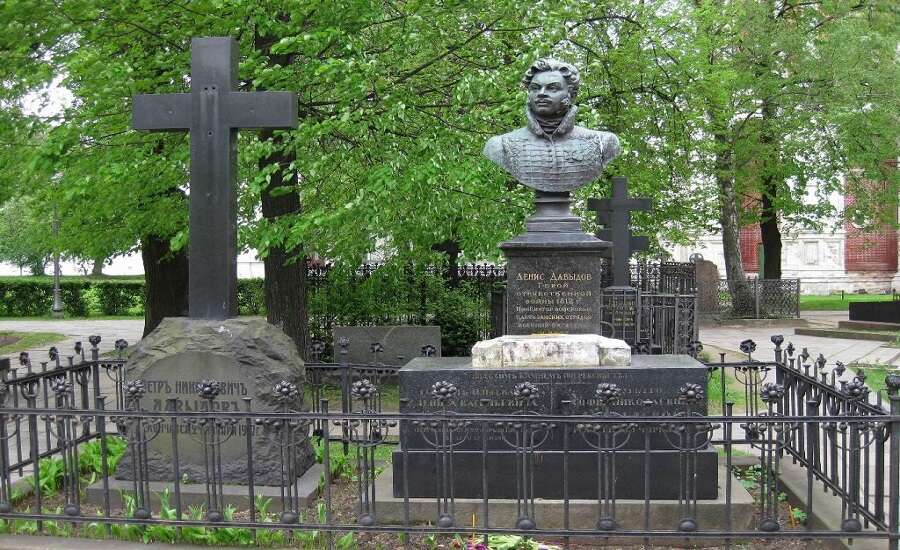
Photo from http://novodev.ru/
The Novodevichy Necropolis was founded in the 16th century as the resting place for Russia’s most honourable statesmen, scientists, writers, and members of the nobility and royal family. In 1898 a new cemetery was developed outside of the convent walls as a burial place for eminent intellectuals and political and military figures. This was further extended in the 1940s as a burial ground for important Soviet figures, and became the most high-profile cemetery in the Soviet Union.
The 1930s desecration of the Novodevichy Necropolis has left less than one hundred tombs, which include those of Decembrists Sergey Trubetskoy and Mikhail Orlov, and Napoleonic hero Denis Davydov. However, the much larger Novodevichy Cemetery extending beyond the convent’s walls is home over 27,000 graves. Some of the cemetery’s most famous inhabitants include writers Nikolay Gogol, Anton Chekhov and Mikhail Bulgakin, opera singer Fyodor Chaliapin, composer Dmitry Shostakovich, theatre director Konstantin Stanislavsky, film director Sergei Eisenstein, founder of the Tretyakov Gallery Pavel Tretyakov, chief investigator of the Chernobyl catastrophe Valery Legasov, Stalin’s wife Nadezhda Alliluyeva-Stalin, and presidents Nikita Khrushchev and Boris Yeltsin. Although slightly morbid, the cemetery is extremely interesting both for its inhabitants and for the design of the tombstones.
Address and Contact Details
Novodevichy Proezd, 1, Moscow, 119435
Tel: Excursion office: +7 (499) 246-8526
Website: https://www.ndm-museum.ru/ , http://novodev.msk.ru/
Email: info@ndm-museum.ru
Nearest metro: Sportivnaya (1.2km), Luzhniki (1.3km)
Opening Hours
Daily 9.00-17.00. Opening hours of different churches varies based on the time of year, consult the website for further details.
Join us on Facebook
We invite you to become a fan of our company on Facebook and read Russian news and travel stories. To become a fan, click here.
Join our own Russian Travel, Culture and Literature Club on Facebook. The club was created to be a place for everyone with an interest in Russia to get to know each other and share experiences, stories, pictures and advice. To join our club, please follow this link.